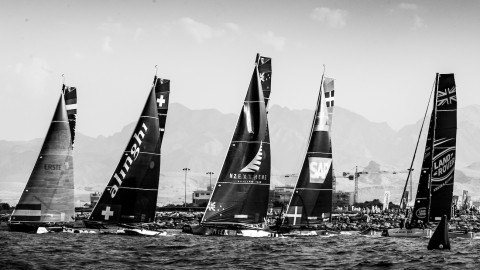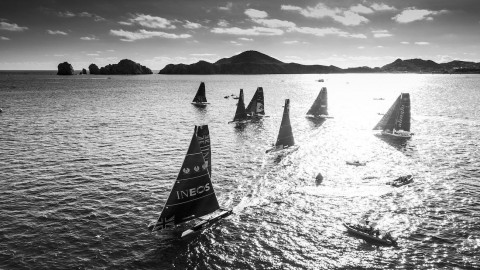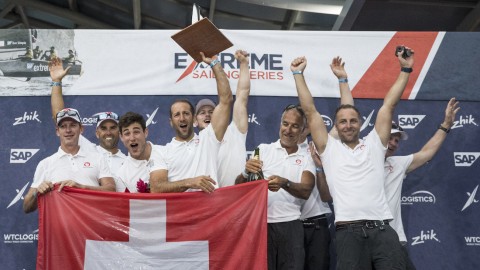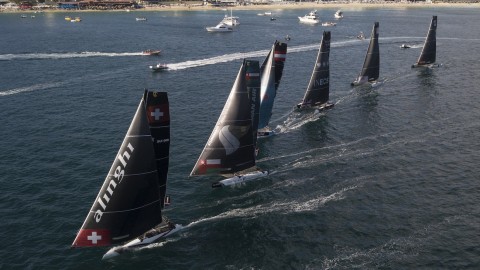GC32s – an “extreme gym” on the water
With the advances in hydrofoiling technology in the past decade, catamaran racing is now faster, more intense and far more physically strenuous than ever, and the sailors competing in the Extreme Sailing Series™ have to be more physically and mentally fit than at any time in the past.
Friday 27th May 2016

With the advances in hydrofoiling technology in the past decade, catamaran racing is now faster, more intense and far more physically strenuous than ever, and the sailors competing in the Extreme Sailing Series™ have to be more physically and mentally fit than at any time in the past.
From agile movements, as they bound across the unstable trampoline during a tack, to the explosive force required to grind a loaded winch as they trim the sheets, each race is a 15-minute intense workout for the sailors, who also have to make split-second tactical decisions. The closest they get to recovery is an isometric hold of their core and leg muscles as they hike out on the hull.
The combination of upper body explosive power and endurance, all on an unstable platform, really is unique to this sport. To put it into perspective, the sailors burn roughly 1,000 calories-an-hour during a race, meaning they can use up approximately 4-5,000 more calories than we would during a typical day in an office. The sailors’ power output is roughly 280 watts through the winch when grinding in a sail, which is equivalent to what an average competitive cyclist puts out during 20 minutes of maximum effort.
Although sailing on board the Extreme 40s in the Extreme Sailing Series was no walk in the park, the shift to GC32s has defined new dimensions and new challenges on the water for some of the world’s elite racing yachtsmen.
James Wierzbowski, bowman for 2016 Act 1 Champions, Oman Air, is a prime example of the new “total athlete” on a GC32. A keen CrossFitter, the Aussie talks us through what it takes to be a sailor in the Extreme Sailing Series and how the GC32s have changed the game.
What is the difference between sailing an Extreme 40 and a GC32 from a fitness point of view?
The biggest difference is that now we have these huge J-foils that we have to adjust for optimum performance. This has definitely added to the workload.
One of my roles on the boat is adjusting the angle of the active J-foil, which is lifting the whole boat up and out of the water. At close to my maximum heart rate I have to calculate the speed of the boat, the waves in our path and any change in direction in order to constantly trim the foils to keep the boat in control and moving as fast as possible.
What sort of training routine do you follow to prepare for racing?
I always put the biggest emphasis on the ability to push through physical pain. It’s a combination of training your muscles to be good at working anaerobically along with working on your mental resilience. This is how you can continue to make clear decisions whilst physically exhausted.
It’s absolutely essential because for so much of the time in this type of racing you are on the limit and, unlike in the gym, you can’t just stop and rest. There’s a job that needs to be done and, if it isn’t, you lose.
What would your average week of training look like?
Sailing is very hard to re-create in the gym environment, but I try to identify the specific components of fitness that, combined with on-the-water training, will result in peak performance. For me I train CrossFit whenever I have a steady schedule. I live in Melbourne so I regularly fly for 20 plus hours, forcing me to have a flexible training routine, but once I have a few days in a row it’s on!
Anyone who has done CrossFit will know how intense it can be with constantly varied, high intensity, functional movements. Most workouts last from five-to-40 minutes and include weightlifting, gymnastics, rowing, swimming and everything in between. Routine is the enemy and the goal is to be doing something every day, whether it is in the gym or pushing myself outdoors.
So it would be impossible to race competitively in this sort of sailing without being massively fit?
Being physically fit isn’t a matter of importance; it’s a necessity. Even if you can perform a skill-based job to a similar degree as someone else, your physical fitness will determine your ability to repeat that role consistently and make effective decisions throughout the day. Once physical fatigue sets in, mental fatigue isn’t far behind, and that’s what is most costly.
Does the unique Stadium Racing format of the Extreme Sailing Series make the physical side of it harder than if you were racing on open water?
The tighter the racetrack the harder we work, it’s as simple as that. Every time you see the boat changing direction it takes a great amount of synchronised effort from the entire team.
To add to this, the stadium style of racing also means that we have a more variable wind to sail in, more encounters with other boats and more complex decisions to make. It really does have a snowball effect; building pressure which increases the likelihood of mistakes.
Presumably the windier it gets, the harder you have to work?
Oh yes. There’s no doubt that when it gets windy, the boat accelerates extremely quickly and everything is amplified. Sometimes this makes the boat handling easier, as we can move faster than the wind, however the physical penalty for a mistake during a manoeuvre is enormous.
A slight error in timing during a tack or a gybe and the boat will rapidly slow down, and when it is windy this can make your job 10-times harder. A few mistakes in a row or early in the day and you can find the fatigue builds and you start dropping down the scoreboard fast.
Being a bowman on board the GC32 must be pretty full-on in any kind of weather?
Bowman is a tough role. I guess you could consider us as working in the engine room. Most of the grunt physical work gets allocated to us, allowing the rest of the team to focus on sail trimming and tactics.




